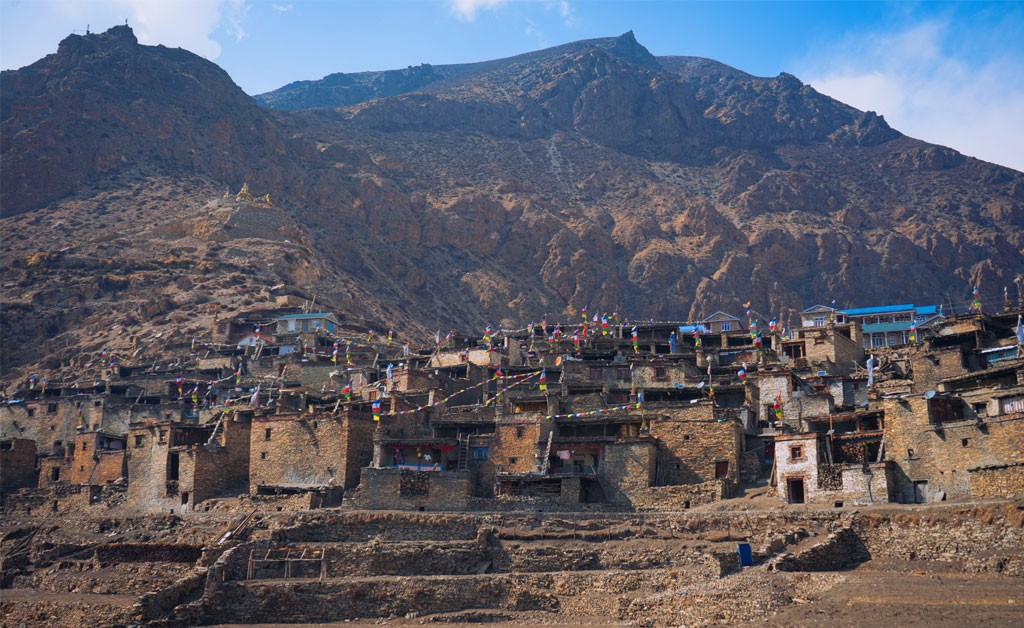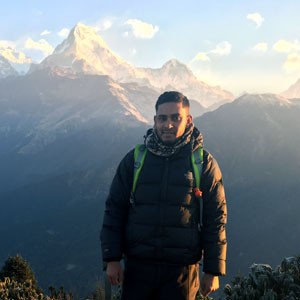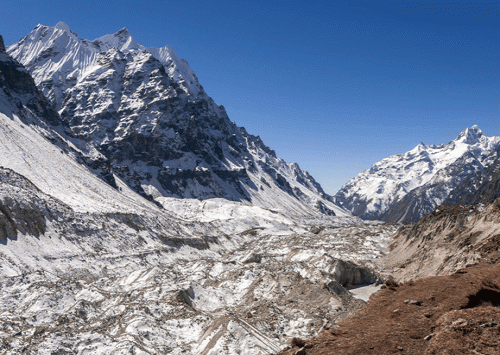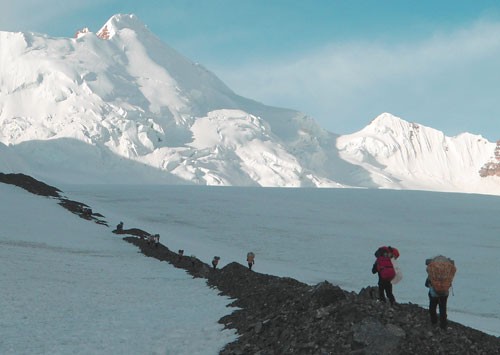Introduction to the Nar Phu Valley Trek
Nar Phu Valley Trek lies on the Northern Annapurna region, near the Tibetan plateau in Manang, is a trekker's paradise. Peaceful trekking route, panoramic landscapes, centuries-old Khampa culture, and wholesome adventure make the Nar Phu Valley Trek an ideal trek in Nepal.
Moreover, it's the least trekked destination, making it a beautiful off-the-beaten-path trek in Nepal. Hence, if you're looking for wholesome trekking other than Everest and Annapurna, a trek to Nar Phu Valley can be best.
The 10-day Nar Phu Valley Trekwith Kang La Pass starts with a drive from Kathmandu to Dharapani. From Dharapani, you'll trek to Koto, Meta, Phu, Naar Village, and Ngawal via Kang La Pass. In between, you'll trek through rustling pine forests, along cascading Naar Khola, arid landslide regions, monasteries, chortens, gompas, ethnic people, and mountain panorama.
The days of walking are long, around 15-17 km each day. However, the serenity and elegance of Nar Phu Valley keep you motivated throughout the trek. Our recommendation for you: the Nar Phu Valley Trek in 2025 can be a beautiful and once-in-a-lifetime junket in the Himalayas.
Before you decide whether this trek is right for you or not, we've detailed some significant elements of the trek. What we've mentioned here is solely based on the experience of our trek leader who's been to Nar Phu Valley multiple times with our trekking groups.
Highlights to Look Forward to
- Panoramic Annapurna (II, III, IV), Pisang Peak, Himlung Himal, Gangapurna, Chulu (East, West, Central), Kangri Himal, and other mountains.
- Trek to Kang La Pass at 5,420 meters, a beautiful and among the highest mountain pass.
- Trek to two beautiful and oldest settlements, Naar and Phu Gaon.
- Acclimatization for a day at Naar Village for adequate rest and preparations to cross Kang La.
- Walk along the serene pine forest, rustling winds, arid landscapes, and cascading Naar Khola.
- Wholesome 10 days adventure with Dream Heaven Adventure, guided by experienced trekking guide.
- Expertly designed itinerary, trek logistics, and utmost safety.
- Fixed departure dates are available for the 2025 season.
Awe-inspiring mountain panorama
If chasing mountains is your thing while trekking, Nar Phu Trek is an absolute fit for you. Encircled by Annapurna mountains from all sides, you'll never run out of mountain glimpses any day. The most beautiful thing is that you'll see some beautiful mountains right from the tea house's courtyard and window. It's that beautiful.
Chronologically, you'll start seeing mountains from Timang, en route to Koto. Two beautiful mountains, Annapurna II and Lamjung Himal sit in your sight all day, from
Dharapani to Koto. From Koto, the mesmerizing glimpse of Lamjung Himal blows you off.
From Meta, you'll get a beautiful panorama of Kangri Himal and Pisang Peak.
Once you walk to Phu, you won't see the panorama of the mountains. However, you'll walk through the most striking landscape of withered humongous boulders, gorges, and serene trails. At Phu, if you climb to the viewpoint, you'll get a clear prospect of Himlung Himal.
From Naar, you'll get a close-range view of Pisang Peak.
Moreover, the Kang La top blesses you with a great mountain panorama. Annapurna (II-IV), Gangapurna, Tilicho Peak, and Chulu appear big, clear, and taller. You'll get awe-struck by the mountain panorama if the weather favors it.
Nar Phu Valley Trek Route- The most peaceful off-beat-path
If crowded trekking routes are not for you, the most peaceful off-beat Nar Phu Trek Route can be your to-trek route. Annapurna and Everest's routes are now getting overcrowded with each year passing. However, very few have heard about this trekker's paradise in the Annapurna region, the serene Nar Phu Valley.
Right after leaving Koto and crossing the suspension bridge over Marshyangdi, you'll get the vibe of what awaits in Nar Phu. The serenity embraces you with a cool breeze and chirps.
With the Himlung Himal expedition in Autumn, this route gets a bit busier. However, in Spring, the trekking route will be all yours. There won't be any trekkers en route, which allows you a peaceful walk all day. All you'll encounter on the trails are the mules and hear cascading rivers and rustling wind.
It feels like a walk in heaven on a peaceful trekking route to Nar and Phu. You'll feel like continuing walking even after getting tired of a 17 km walk. The lone stupas and chortens greet you peacefully. The mountains around you make you feel great and peaceful.
Kang-La Pass: An adventurous high Himalayan Pass
On the 8th day of the 10-day-long Nar Phu Valley Trek, you'll cross Kang La Pass at 5,320 meters above sea level. This altitude is the highest you'll reach on Nar Phu Trek. Just a reminder, crossing Kang La isn't easy. But with a proper mindset and a day of acclimatization at Naar, with our experienced trek guide, you'll cross it in no time.
Reaching Kang La top bestows with panoramic mountain panorama and a sense of accomplishment. The show shines bright, the sky seems deep blue, and the freezing wind gusts push you, but the wholesome adventure keeps your adrenaline atop.
Ancient Buddhism, Enriched Culture, and Tradition
Nar Phu Valley has a great history of Khampa warriors, traditional Buddhism, and unblemished Tibetan-influenced culture and tradition.
Tashi Lhakhang Monastery in Phu Gaon is among the 108 prominent Buddhist monasteries in the world. Locals believe that it was built 230 years ago. The major rituals and functions in the village take place at this monastery. With its utmost significance, it's a popular place you'll visit on this trek.
During June and July, the locals here cultivate potatoes and barley. The entire Naar Valley becomes lively with greenery. The locals become busy harvesting in October, which is worth experiencing firsthand on your acclimatization at Naar village.
Also, they take part in several festivals associated with Buddhism. The local monasteries allow trekkers to visit gompas and monasteries during celebrations and rituals. Withered Khampa settlements, stone-built settlements, stupas, chortens, and prayer flags reflect the enriched culture of Nar Phu Valley.
Best Time for Nar Phu Valley Trekking
Nar Phu Valley Trekking is doable during Summer, Spring, and Autumn.
Autumn in Nar Phu sees Himlung Himal expedition groups, making it a busier time. The greenery, wild flower bloom, the farmlands full of wheat and potatoes, and liveliness make September and October the best time. The crystal clear weather in November is another beautiful month for this trek.
Spring months, from March to May are the best time in the year for this trek. Rain-free days, utmost visibility, snow-capped mountains, and warm temperature makes these months the best. Also, in the Spring months, not many trekkers trek to Nar and Phu, making it crowd-free.
In winter, the snow and freezing temperatures make most tea houses remain closed. People from Nar and Phu settle down in lower regions to escape the cold. Hence, trekking here in winter, from December to early March, is a waste.
September and October are warmer months with daytime temperatures around 7-8˚C. However, the temperature drops significantly in November. The temperature at Nar and Phu Villages averages around freezing even during the day. Not to mention, the nighttime temperature drops to -15˚C in November.
The temperature in Spring gets warmer as the month progresses. The daytime temperature in April and May rises to 8-10˚C. Similarly, the nighttime temperature also increases to -8˚C.
Trek Guides and Porters
We'll provide you with an experienced trekking guide and a trekking porter for Nar Phu Trek in Nepal. Based on the group size, the number of trek guides and porters may vary.
We'll provide you with a trekking guide who's trekked Nar Phu Valley several times. Also, our strong trek porters carry your backpack throughout the trek so you can walk comfortably.
We purchase travel insurance for our trek guides and porters. Also, we pay them as per industry standards.
Our trek guides and porters ensure your utmost safety and a wholesome trek experience.
Physical Fitness and Trek Preparations
Physical fitness is a must if you're considering Nar Phu Trekking in 2025. Although it's a moderately straightforward trek, it demands endurance. You've to walk 17-18 km each day, except for a 5 km distance between Naar Phedi and Naar.
Hence, endurance is a must for this trek. Although you'll get a trekking porter, walking alone with a lightweight backpack for long hours tires you. Furthermore, you must train out on cardio. Swimming, cycling, and running are best for cardio. Also, if possible, you must go on short day hikes before joining our fixed departure group.
Please start to train cardio and endurance for a few months before joining the trek.




